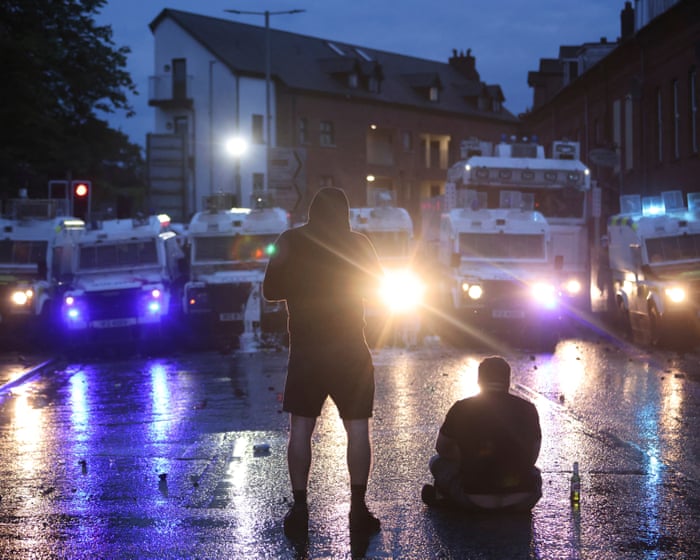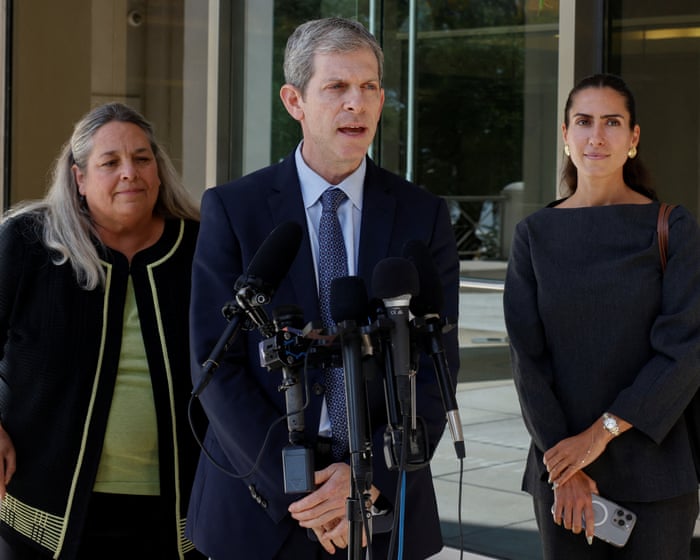Northern Ireland is facing a “permacrisis” due to recurring racial riots, and government documents suggest military bases may be needed to shelter people forced from their homes. Officials fear the region is experiencing prolonged instability, and that a single local or international incident could trigger widespread disorder.
The warnings indicate that some displaced families have gone “off-grid” for safety, and authorities may struggle to provide secure emergency housing if violence flares up again. These concerns were detailed in emails, meeting minutes, and other documents obtained by the news website the Detail and shared with the Guardian, following a summer of anti-immigrant violence in towns like Ballymena and Larne that drove many families to flee.
An official from the executive office of First Minister Michelle O’Neill and Deputy First Minister Emma Little-Pengelly described the situation as a “permacrisis” during a multi-agency meeting in July, citing the recurring nature of public unrest.
The documents also reveal that the public housing register was taken offline for at least six weeks to protect potential targets, and that foreign health workers were offered personal safety alarms, security escorts, and police patrols last year.
Hundreds of pieces of correspondence, obtained through freedom of information requests, show officials’ deep concern that recent racial violence could escalate. Immigrants have slowly arrived in Northern Ireland since the 1998 Good Friday Agreement, but ethnic minorities still make up only 3.4% of the population—far less than in the rest of the UK. Despite this, non-white families, especially in loyalist areas of County Antrim, have faced years of vandalism and intimidation.
Riots in England in July 2024 spread to Belfast, where mobs targeted foreign-owned businesses. In June, Ballymena saw attacks on the homes of Roma families and other foreigners. A vigilante group in east Belfast, calling itself the Belfast Nightwatch First Division, has been challenging dark-skinned men to show identification, with similar groups reportedly forming elsewhere in the city.
Officials are preparing for more crises. One Department of Communities official noted in June that support center locations could not be shared after masked men burned down a leisure center in Larne that had sheltered displaced families. Staff organizing emergency housing faced intimidation, raising concerns about their ability to operate safely. The official suggested that secure Ministry of Defence sites might be the only viable option, though the riots subsided in mid-June before such measures were needed.
Tracking displaced individuals, especially those who went “off-grid,” proved difficult, with worries that children were missing school. Unaccompanied asylum-seeking children under health trust care were advised to lock doors and windows, keep phones charged, and take other security precautions.
A spokesperson for Stormont’s executive office stated that authorities have formed coordination groups to improve community relations and reduce the risk of further unrest, emphasizing that tackling racism is a key part of efforts to build a more inclusive society.
Patrick Corrigan, Amnesty International’s Northern Ireland director, said the documents reveal the “terrifying impact” of racist violence.Violence. “The likelihood of more racist violence seems certain. What is less clear is whether the Northern Ireland authorities are prepared to take action to keep people safe.”
Geraldine Hanna, the Northern Ireland Commissioner for victims of crime, said the displacement of vulnerable people, especially children, was deeply distressing and required urgent attention. “The events in August 2024 and June 2025 were not isolated incidents but part of a troubling pattern of violence and intimidation that has left many victims traumatized and entire communities living in fear.”
Quick Guide
Contact us about this story
Show
The best public interest journalism relies on firsthand accounts from knowledgeable sources. If you have information to share on this subject, you can contact us confidentially using the methods below.
Secure Messaging in the Guardian app
The Guardian app includes a tool for sending tips about stories. Messages are end-to-end encrypted and hidden within the app’s normal activity, making it difficult for anyone to detect that you are communicating with us or to see what you are saying.
If you don’t have the Guardian app, you can download it (iOS/Android) and go to the menu. Select ‘Secure Messaging’.
SecureDrop, instant messengers, email, telephone, and post
If you can safely use the Tor network without being monitored, you can send messages and documents to the Guardian through our SecureDrop platform.
For more details, our guide at theguardian.com/tips lists several secure ways to contact us and discusses the advantages and limitations of each method.
Illustration: Guardian Design / Rich Cousins
Was this helpful?
Thank you for your feedback.
Frequently Asked Questions
Of course Here is a list of FAQs about government documents cautioning a persistent risk of racerelated riots in Northern Ireland presented in a clear and natural tone
Beginner Definition Questions
1 What kind of government documents are we talking about
These are official reports threat assessments and security briefings published by bodies like the Police Service of Northern Ireland or the Northern Ireland Office They analyze community tensions and potential risks
2 What does persistent risk actually mean
It means the underlying conditions for racerelated riots are always present It doesnt mean a riot is happening right now but that the potential for one is a constant feature that authorities must monitor
3 Why is Northern Ireland specifically mentioned for this risk
Northern Ireland has a history of sectarian conflict While this was primarily between Protestant and Catholic communities the same patterns of segregation mistrust and organized group violence can sometimes be redirected towards new ethnic minority communities
Understanding the Causes Context
4 What are the main causes behind this risk
Key causes include preexisting community tensions misinformation and racism spread online competition for resources like housing the activity of organized hate groups and a lack of integration between established and new communities
5 Are these riots between different ethnic groups or against ethnic groups
The primary concern documented is violence directed against ethnic minority communities by individuals or groups from the majority population It can also involve clashes between different minority groups though this is less common
6 Has this happened before
Yes There have been several significant incidents such as targeted attacks on the homes of migrant families and largescale protests that turned violent leading to families being forced to flee their neighborhoods
Impact What It Means for People
7 How does this persistent risk affect everyday life for residents
It can create an atmosphere of fear and anxiety for ethnic minority communities It may influence where people feel safe to live socialize or send their children to school It also means police resources are consistently dedicated to monitoring and preventing such outbreaks
8 Does this mean its not safe to visit or live in Northern Ireland
For the vast majority of visitors and residents Northern Ireland is a safe place The persistent




